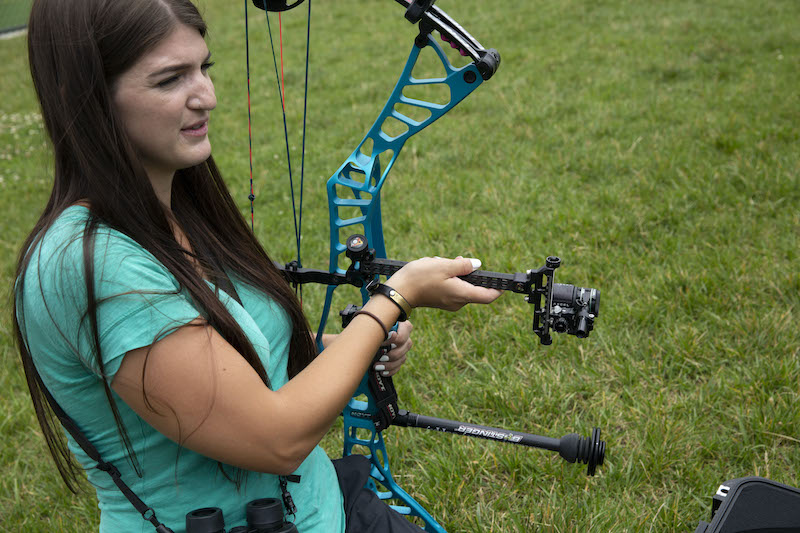Need to choose a sight for your compound bow? You want one that fits your budget, style of shooting and the type of shooting you’ll be doing.
Let’s start with the basics. All compound bows have a series of threaded holes on the face of the riser opposite and above the shelf. These holes are universal; any sight you buy for a compound bow can be attached using those holes.
The sight extends in front of the bow – some farther than others – and has a round housing at the end. Inside that housing, there might be a single sight pin, multiple pins, or a lens with a dot on it. You’ll pick what’s inside the housing based on what you’re doing with the bow.
BAR LENGTH

Today’s bow sights offer bars of varying lengths. The bar determines how far away from the bow the sight housing sits. Sights with long bars are usually adjustable.
The shorter the bar, the closer to the bow the sight housing will sit. That’s great for hunters who don’t want accessories sticking out and catching tree branches and brush.
However, the shorter the bar, the less precise you can be with your aiming. Look at an object in the distance and use your finger as a pretend sight pin. When your finger is closer to your eye, you might completely cover your target. Move your finger, and you can really fine-tune where to paste your “pin.” The same principle applies to bow sights.
Also, the shorter the sight bar, the less pin movement you’ll see. Having a longer sight bar will encourage you to hold the bow steadier as you aim, because you will notice every waver of the pin.
MULTI-PIN VS SINGLE PIN
Some sight housings have multiple pins, whose positions are fixed, while others will have one pin that’s adjustable. The pins on a multi-pin sight are typically set in position by the archer at various distances, and then locked into place. So an archer using a sight with four pins, for example, might set those pins to provide aiming references for shooting at 20, 30, 40 and 50 yards.
Multi-pin sights are favored by bowhunters who want fixed aiming references that they don’t have to move when game animals come close. Also, you can find target competitions with bowhunter classes that require fixed pins under the division equipment rules. If an animal or target is standing at an odd distance, like 25 yards, the archer has to know how to aim high or low using the fixed pins to accurately shoot.
Single-pin sights are a good choice for bowhunters and target archers who want an exact aiming reference regardless of the distance. These sights have one pin that’s adjustable. Archers will add sight tape that includes markings for distances that might range from 10 yards to 100 yards. The correct tape for a given sight is one that correctly accounts for an arrow’s weight and flight speed. If archers want to shoot at an animal or target that’s 37 yards, for example, they will adjust the sight according to the tape so the pin is set exactly for a 37-yard shot.
3D target archers not competing in a bowhunter class mostly use these sights to create an exact aiming point for every target on a 3D course, regardless of distance. Some bowhunters choose single-pin sights for the same reason. But they can run into trouble if they set the sight for a certain distance and the game animal suddenly moves closer or farther. In that case, the archer would have to reset the sight or guess where to hold the sight pin to accurately aim.
PIN SIZE
Sight pins will vary in size, with .010, .019 and .0129 inches being the most common. The bigger the pin, the easier it is to see, but it will cover more of your target. The smaller the pin, the more precise you can aim, but the smallest pins go dark in low light before larger pins.
FIBER LENGTH
Fiber length is critical to how well you can see your sight pins, especially in low-light situations, such as early morning, late evening, or when shooting under a heavy tree canopy. The more fiber a sight pin has, the more light that fiber captures and delivers to the pin head, which is what you see when aiming.
MAGNIFYING LENS
Sight housings with magnifying lenses are almost exclusively used by target archers. These can be used in conjunction with a single sight pin, or the lens may have a dot in the center or small piece of fiber optic for an aiming reference.
The magnifying lens allows archers to see exactly where they are aiming on a target. In addition, any movement by the archer is magnified, which is a good way to learn how steady you’re holding your bow.
AXIS ADJUSTMENTS
When buying a bow sight, consider the ability to level the sight. To make sure your aiming references are true regardless of distance or shooting angle, your sight must be level with the ground. To achieve this, you must adjust the sight’s second and third axis. Sights that offer these adjustments tend to be more expensive, but this feature is valuable.
How will you know if a sight has these adjustments? Check the packaging. If a sight allows for axis adjustments, the manufacturer will state that.
If you hold a bow sight at arm’s length, the second axis allows the sight housing to move in a circle around the sight bar, like the hand of a clock. The third axis allows the sight to swing into position like a door. Watch a few YouTube videos to learn how to adjust these axes to level your sight.
The best bow sight for you is one that helps you achieve all your archery goals. If you need help considering these many options, visit your local archery shop and talk with a pro.




